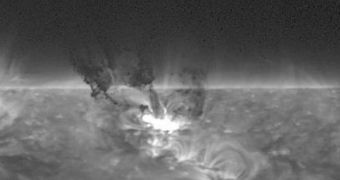On Tuesday, June 7, the Sun produced a large-scale solar flare, that observatories belonging to numerous space agencies were able to observe and analyze. The European Space Agency's (ESA) Proba-2 microsatellite was one of these spacecraft.
Our Sun is constantly being monitored by a number of dedicated telescopes, including the Solar Dynamics Observatory, STEREO, SOHO and others. Each of them focuses its observations on a specific wavelength or phenomenon, but together they provide a comprehensive view of the star.
Proba-2 is an European microsatellite, about a cubic meter in volume, which sports numerous innovations in terms of space-based instruments and capabilities. In addition to being able to conducting actual science, the spacecraft is also a technology testbed.
Its main mission is to survey the Sun, and it uses five instruments to do so. Two of them are dedicated specifically to monitoring the entire star. The first is the extreme ultraviolet wavelength (EUV) Sun Watcher using APS and Image Processing (SWAP) instrument.
The second one is called the Lyman Alpha Radiometer (LYRA). The three other are the Dual segmented Langmuir probe (DSLP), the Thermal Plasma Measurement Unit (TPMU) and the Science Grade Vector Magnetometer (SGVM). All three measure the basic properties of solar plasma.
Now that the Sun is finally reaching a maximum in its standard, 11-year-long cycle, the instruments spring into action more and more. The new solar flare again demonstrates that the star is starting to wake up, and to approach a period of intense activity, in 2012-2013.
Tuesday's event was a medium-class M2.5 solar flare, that triggered a coronal mass ejection (CME), otherwise known as a proton storm. The events were accompanied by a burst of radio energy.
The gas in the solar flare “was relatively cool – about 80 000ºC – which explains why it appears quite dark at the extreme ultraviolet wavelength of SWAP,” ESA officials say in a press release.
“Much of this gas then fell back to the Sun, with dark downflows that brighten as they fall, probably due to localized heating. This darkening actually caused a decrease in the average intensity seen by SWAP,” the document adds.
The 130-kilogram Proba-2 is the second of its series. With the Proba constellation, ESA aims to test the possibility of sending low-cost, low-weight, microsatellites to space, in order to conduct science that is generally conducted with much larger spacecraft.

 14 DAY TRIAL //
14 DAY TRIAL //